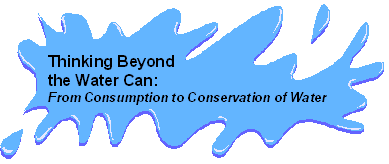
Most cities, towns and villages are facing water stress - their reserves of water is depleting, while the demand for water is increasing. Each day, they are finding that water is more scarce. Much of the rain that falls on their catchment areas either evaporates, or becomes run-off as surface water, with a small percentage that replenishing scarce ground water. Geology of the catchment areas plays a critical role in ground water contamination. Contaminated ground water can remain in such areas for days or even decades, affecting future generations that will increasingly be depend on ground water. Water pollution (and as an extension, ground water contamination) comes from thousands of sources, including siltation, nutrients, bacteria, oxygen-depleting substances, metals, pesticides, herbicides, toxic chemicals, and other habitat-altering materials. Much of these sources are directly related to our daily lifestyle choices and values that we place on the environment. We need to make ourselves aware of the impact and effects of these choices and values to water sources, and the environment at large. Maintaining an adequate supply of usable water is increasingly a challenge. The demand for water needed to serve agriculture, industry, sanitation, and domestic consumption increases along with population, development, and economic growth. Water resources are required for many aspects of power generation, waste processing, new home construction, new industries and recreation. All this has meant that the mean daily demand for water has consistently outstripped the mean flow of available water. This hardly takes into account the other effects/impacts of scarce water - on fish and other forms of aquatic life, for example. The World Health Organization estimates that good health and cleanliness requires a daily supply of about eight gallons of water per person. But current levels far exceed this requirement - Americans consume 170 gallons; Europeans about 60 gallons. While a number of actions can be taken at the macro (global, national and sub-national levels) to mitigate these doomsday scenarios, the real challenge lies in interpreting such scenarios in terms of action that is needed at the micro (individual and household levels) that have eventual and cumulative (and positive) macro impacts. Simple steps can be taken in and around the home. Installing high-efficiency shower heads and taps, low-flush toilets, go a long way in conserving water on an annual basis. Cleaning and repairing leaky fixtures are another way. Clearly behaviour patterns - a conscious and consistent behaviour that reduces the use of water is critical. Simulating citizens' conservation is essential for preserving our water. Looked at from an individual's point of view, a water conservation programme will require the following issues to be incorporated:
The problems related to water is visible - but what awareness needs to be generated? At what level? Who are the target groups? What is the message to be disseminated? Who should disseminate? Where will information for awareness building come from? Who 'owns' that information?
Monitoring local water bodies and catchment areas, and constant research and analysis is an essential aspect of an integrated approach that generates a body of information and results that will again enable appropriate and critical decisions to be taken. Research and monitoring not only involves local universities or government agencies, but the community itself - especially in the monitoring of rivers and lakes on a regular basis. What aspects of water bodies - rivers and lakes, for example - need to be monitored? Who should do the monitoring? What methods and skills will be need for this purpose? Where will the results be documented and informed to a larger audience?
How do households make decisions regarding water use and conservation? What incentives - carrots and sticks - are necessary to change behaviour patterns? What technology choices are available for changing water consumption patterns? How, when and where should such info be provided to individuals and households?
|
| Return to Water Resources Contact: Hari Srinivas - hsrinivas@gdrc.org |
